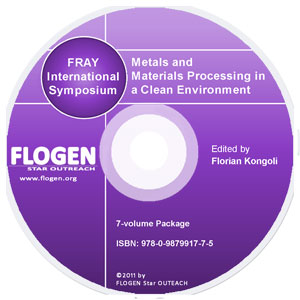
CD shopping page |
2011-Sustainable Industrial Processing Summit
|
| Editors: | Florian K |
| Publisher: | Flogen Star OUTREACH |
| Publication Year: | 2012 |
| Pages: | 708 pages |
| ISBN: | 978-0-9879917-1-3 |
| ISSN: | 2291-1227 (Metals and Materials Processing in a Clean Environment Series) |
Microstructure Of Solidified Mold Slags And Comparison With Laboratory Specimens
Irmtraud Marschall1; Nathalie Koelbl2; Harald Harmuth3; Guangmin Xia4;1MONTANUNIVERSITAET LEOBEN, Leoben, Austria ; 2MONTANUNIVERSITAET LEOBEN, Leoben, Austria; 3MONTANUNIVERSITAET LEOBEN, 8700 Leoben, Austria ; 4VOESTALPINE STAHL GMBH, Linz, Austria ;
Type of Paper: Regular
Id Paper: 355
Topic: 5
Abstract:
Five slag film samples including their slag rims of a single mould flux and its associated mould flux were collected after service during tail out. These slag films were obtained after casting of three different alumina killed steel grades. They were located up to 100 mm down the mould from the meniscus. For all samples distinguishable layers could be observed: In contact with the mould a mainly glassy phase, with little crystallisation, a well crystallised layer and a solidified layer, which had been liquid during casting. Like most of all fluorine containing, silica based mould slags cuspidine is the prevailing crystal phase in the crystalline layer. With increasing Al2O3 contents, due to the contact with alumina alloyed steel grades, nepheline was formed beside cuspidine. Here the change of the cuspidine crystal shape is remarkable.Contrary to the slag films the slag rims consist partly of crystallised slag as well as sintered powder. It was found that the casting temperature is the determining factor for the generated slag rim size that will generate. In addition quench tests of the original mould powders as well as investigations with the hot stage microscope were carried out. DTA and viscometer of the original mould powder and the slag films were performed to reconstruct the microstructure under service conditions and to define a crystallisation sequence. All methods revealed the impact of the Al2O3 pick-up on the crystallisation temperature and the viscosity as well as on the phase composition of the slag films and the crystal shape. Comparing the results of the original slag under laboratory conditions with the results from casting, laboratory tests will give a hint on the slag film structure that will be formed during casting. Chemistry modifications, temperature gradient within the mould and temperature fluctuation during casting have an impact on deviations.